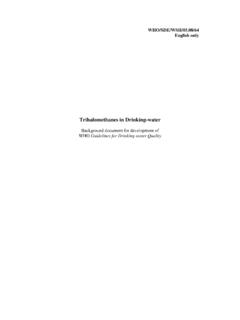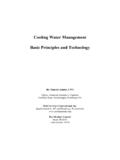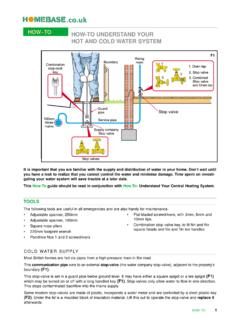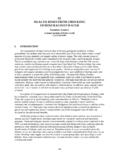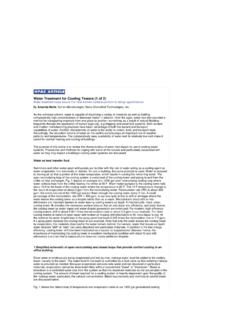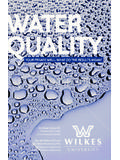Transcription of 1. eRoSIoN BY WAteR
1 1 Types and forms of eRoSIoN ANNEX. by WAteR and by wind 1. eRoSIoN BY WAteR . eRoSIoN by raindrop impact ( splash ). eRoSIoN degree: very weak; value = 1. This form of eRoSIoN is no longer visible after cultivation (ploughing, hoeing etc.). Splash eRoSIoN is a two step process: Break up of soil clods/aggregates and dispersion of soil particles by the kinetic energy of the raindrop impacting on the soil. The dislodged particles may or may not be then moved down slope by surface runoff, and the detached soil particles resettle on the soil surface or are thrown onto plant stems and leaves (herbaceous vegetation or young seedlings). Sheet eRoSIoN This is the type of eRoSIoN that results from runoff that spreads across the soil surface during rainfall ( when the infiltration rate has been exceeded). It may take various forms and degrees. Manual for Local Level Assessment of Land Degradation, Sustainable Land Management and Livelihoods Part 2 Field methodology and tools pp Diffuse runoff: pp Surface scratches: eRoSIoN degree: very weak, eRoSIoN degree: weak, value = 1 value = 2.
2 This takes place during the rain as soon as The first traces resulting from fast, concentrated the infiltration rate is exceeded and a film surface runoff on sloping surface. The depth of of WAteR starts to move across the surface. the scratches does not exceed a few centimetres Effects are limited to the transport of and are easily removed by cultivation. fine particles and development of a sandy film in small cultivation furrows (traces) pp Rills: or where the fine particles are trapped by eRoSIoN degree: weak, small clumps of herbaceous vegetation. value = 2. There may be occasional dislodging of Soil eRoSIoN due to the grooving action by small superficial roots. many small rivulets and WAteR channels caused by concentrated surface runoff. Rills do not pp Removal of surface soil particles: exceed 30cm in depth and they can be readily eRoSIoN degree: weak, removed by cultivation.
3 Value = 2. A very slight reduction in soil depth due pp Small gullies: to down slope transport of soil particles. eRoSIoN degree: Weak, Removal of the surface layer does not value = 3. reach the next soil layer (subsoil). Some These are shallow gullies less than 1m deep roots of grasses, annual plants or trees may that cannot be removed by ordinary cultivation. be exposed. Gullies: more than 1m deep that may be pp Removal of surface soil with some individual gullies separated from others or excavation: contiguous. eRoSIoN degree: Moderate, value = 3 pp Individual gullies: This is the most advanced form of soil loss, eRoSIoN degree: moderate, through removal of material and part of value = 3. the soil profile with a tendency to develop into gullying. This state is accompanied pp Individual gullies accompanied by by exposure of tree roots and exposure of collapse of the gully sides and /or the subsoil horizon.
4 Tunnel eRoSIoN (subsurface eRoSIoN creates a tunnel that then collapses): eRoSIoN degree: severe, Linear eRoSIoN value = 4. This is eRoSIoN due to concentrated runoff pp Widespread gullies: accompanied by scratching or scoring of the soil eRoSIoN degree : severe, surface to various degrees. value = 4. 172 LAND DEGRADATION ASSESSMENT IN DRYLANDS (LADA) PROJECT. ANNEX 1. Types and forms of eRoSIoN by WAteR and by wind pp Badlands: Landslides;. eRoSIoN degree very severe, torrential lava flows (suggest remove ?);. value = 4 mudflows. Linear eRoSIoN also occurs in areas that are pp - Superficial mass movement: periodically flooded in the beds of waterways, eRoSIoN degree: weak, in flooding areas around oueds , in floodplains value: 2. of rivers / alluvial deposition zones (know as This type of landslip affects non plastic materials garaats , and sebkhas in northern Africa ). (concave), clay soils with characteristic uneven terrain (solifluction lens) or other forms such as The suggested degrees (rills - 2, small gullies - small terracing, or creep 2; gullies - 3), may scored at one degree less if there are no envisaged negative impacts on the pp Deep mass movement: hydrological regime (flow quantity and quality), eRoSIoN degree: moderate on infrastructure along waterways or risk to to severe, value : 3 to 4.
5 People. However, if the risk is high the degree More significant land or mud slides that may be should be 4. localised or widespread. This includes landslides in the form of a slab, and mudflows. Mass movement The figure below illustrates one type of mass movement known as rotational concave Type of eRoSIoN caused by soil saturation and landslide and shows the tongue (langue in gravity and set off by intense and/or prolonged French) of the landslide and the detachment rainfall. plane (niche d'arrachement in French) (source Roose, 1994). tongue detachment niche figure 23 Rotational concave landslide LAND DEGRADATION ASSESSMENT IN DRYLANDS (LADA) PROJECT 173. Manual for Local Level Assessment of Land Degradation, Sustainable Land Management and Livelihoods Part 2 Field methodology and tools Mass movements (slow or fast) result from an Accumulation: imbalance between the soil mass, the stored Degree from very weak to WAteR and vegetation cover, the friction forces of severe, with values from 1 to 4.
6 These materials on the weathered bedrock and the slope of the materials (limiting slope 30 to It is the deposition of soil / sand particles that 40 degrees / 65 %). This imbalance can develop have been transported when the wind loses gradually on one or more slip planes following speed or becomes too laden. It can take several wetting or by exceeding the point of elasticity forms according to the power of aggression. of the soil (slow landslides with deformation but without breaking up) or liquid materials Areas severely affected: well developed (mudflows). dune fields with or without vegetation Areas moderately affected: accumulation of material trapped at the edges of fields 2. WIND eRoSIoN or along roads;. Diffuse accumulations: sandy layers Wind eRoSIoN is the form of soil degradation by around herbaceous vegetation and fine the action of the wind which abrades, transports sand deposits less than 2 to 3 cm depth.
7 And deposes soil / sand particles. These actions characteristic of areas only weakly depend mainly on the type of soil, the climate, affected by wind eRoSIoN . the vegetation cover, the speed and frequency of wind. Deflation Accumulation Deflation: Degree very weak to severe, values from 1 to 4. It is the action of removal of soil/sand particles which results in a loss of the surface soil layer, appearance of a stony surface and exposure of plant roots. The degree of eRoSIoN depends on the abrasive power of the wind effect on the land, it varies from weak to severe, with values from 1 to 4 for the most severe. Deflation is sometimes accompanied by corrosion. 174 LAND DEGRADATION ASSESSMENT IN DRYLANDS (LADA) PROJECT. 2 Some general and specific ANNEX. crop nutrient deficiencies Manual for Local Level Assessment of Land Degradation, Sustainable Land Management and Livelihoods Part 2 Field methodology and tools Table of nutrient deficiencies and toxicities generalised symptoms and conditions Essential nutrient Deficiency/Toxicity symptoms Typical conditions Nitrogen (N) Leaves (first older ones) turn Sandy soils under high rainfall yellow/ brown, plants are spindly, conditions and soils low in organic lack vigour and may be dwarfed.
8 Matter, where leaching occurs. Phosphorus (P) Not easily detected from Acid soils rich in iron and appearance. Where deficiency is aluminium oxides ( red tropical severe plant will be stunted, the soils). leaves will take on a purplish tint and the stem will be reddish in colour. Potassium (K) Yellow/brown spots appear on More frequent on light soils (as K. older leaves and/or necrosis of is concentrated in the clay fraction edges. of soils). Sulphur (S) Leaves are stunted, with uniform chlorosis. Calcium (Ca) Roots are usually affected first Acid soils, or alkali or saline soils growth is impaired and rotting containing high proportions of often occurs. In vegetative growth, sodium. deficiency may show in distorted leaves, brown scorching or spotting on foliage or bitter fruit ( apple) or blossom-end rot ( tomato). Magnesium (Mg) Interveinal chlorosis, first on older Acid, sandy soils in areas with leaves.
9 Moderate to high rainfall. Often occurs in conjunction with Ca deficiency. Iron (Fe) Chlorosis of younger leaves. Calcareous soils, poorly drained and with high pH. (In neutral and alkaline soils P may prevent the absorption of Fe.). Manganese (Mn) Chlorosis of younger leaves. Badly drained soils, over-liming or deep ploughing of calcareous soils can lead to Mn deficiency, as can the presence of high levels of Mg. The combination of high pH values (> ) and high levels of organic matter can immobilise soil Mn. Zinc (Zn) Symptoms vary with plant type Soils with high pH. Available Zn is in cereals young plants display reduced by the application of lime purpling, whereas in broad- or phosphates. leaved plants symptoms include interveinal chlorosis, reduced leaf size and sparse foliage. Copper (Cu) Chlorosis of the tips of the Peat soils, or leached sandy or acid youngest leaves and die-back of soils.
10 Growing points. 176 LAND DEGRADATION ASSESSMENT IN DRYLANDS (LADA) PROJECT. ANNEX 2. Some general and specific crop nutrient deficiencies Table of nutrient deficiencies and toxicities generalised symptoms and conditions (continued). Essential nutrient Deficiency/Toxicity symptoms Typical conditions Boron (B) In crops, other than cereals, the Sandy soils, dry conditions and apical growing point on the main liming can result in B deficiency. stem dies and lateral buds fail to develop shoots. Molybdenum (Mo) Marginal scorching and cupping Acid soils or soils with high pH. Mo of leaves. Wilting is common in deficiency can lead to N-deficiency Brassicas. as nitrate requires adequate supplies of Mo for metabolism. Mo availability can inhibit the uptake of Cu. Chlorine (Cl) Wilting of leaves. Well-drained, sandy soils. Sulphur Toxicity Build up of sulphates as a result of irrigation Manganese Toxicity Brown spots and uneven Soils with pH of < (for chlorophyll in older leaves.)











